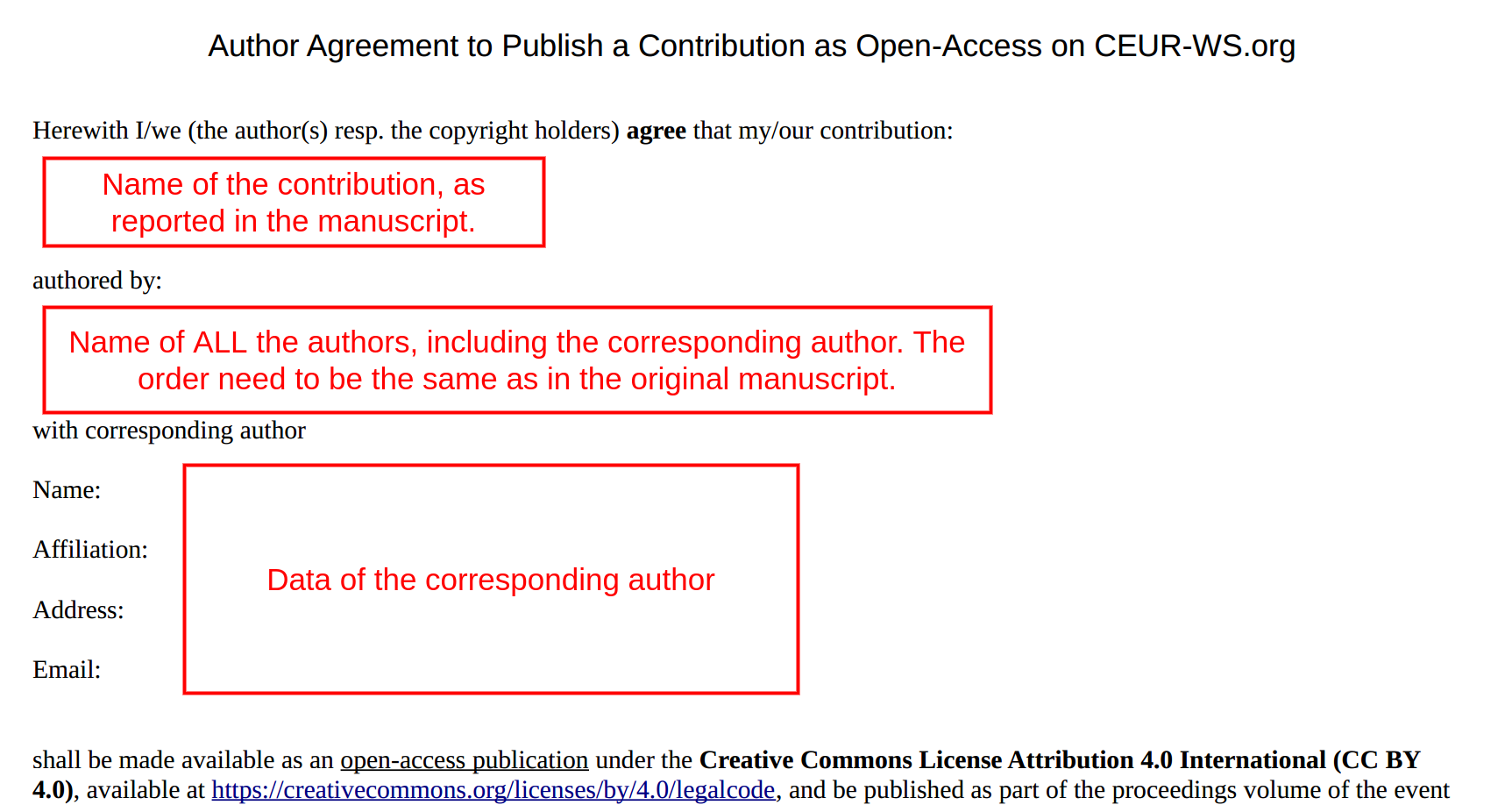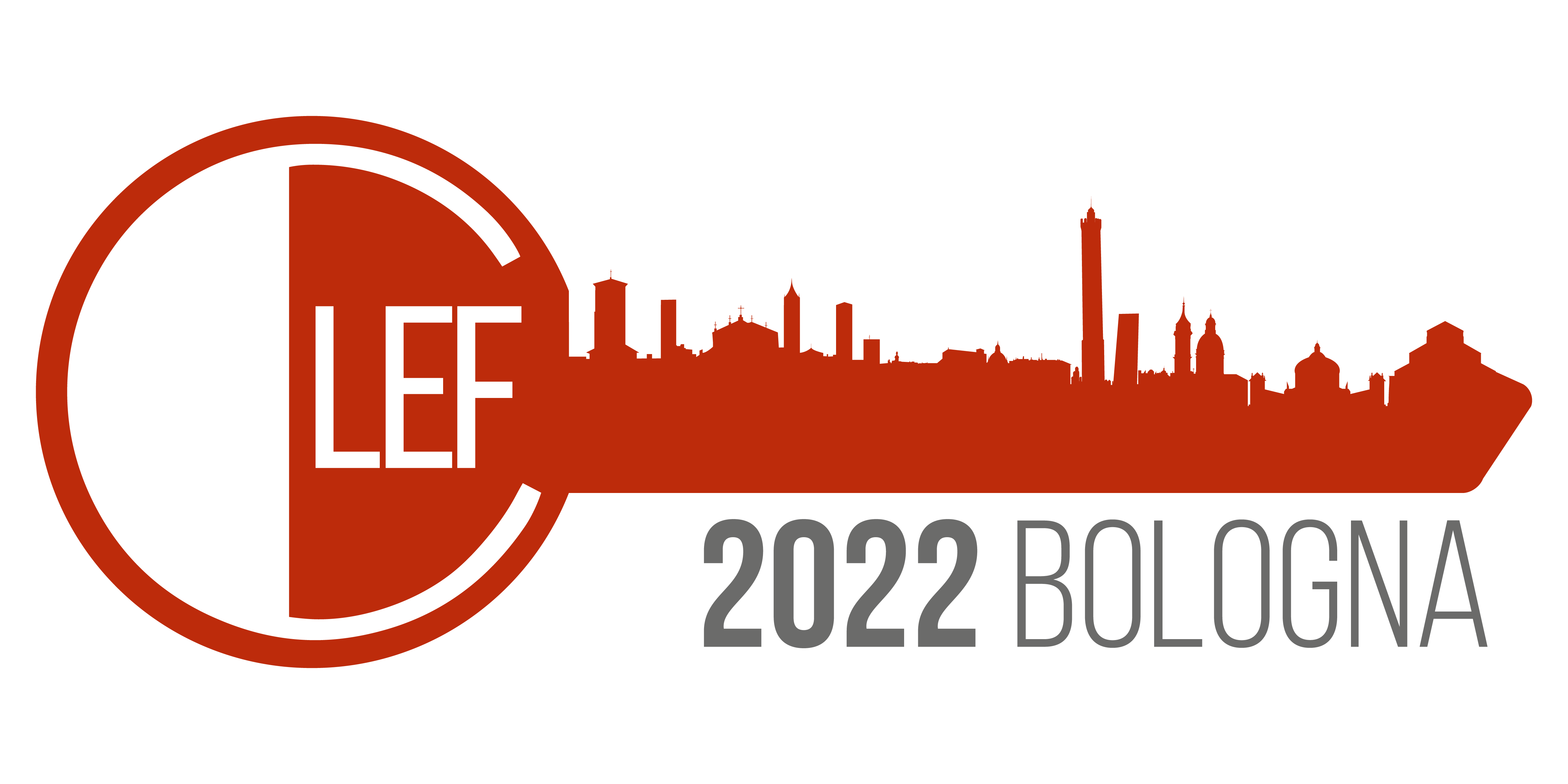Instructions for CLEF 2022 Working Notes in the CEUR-WS Proceedings
As usual, the CLEF 2022 Labs working notes will be published in the CEUR-WS.org proceedings. The
electronic Working Notes will be organised according to the Labs. If one group
participates in more than one Lab, separate reports are to be submitted.
Moreover, for those Labs that are subdivided within several tasks, separate
reports for different tasks are to be provided.
The CLEF 2022 Working Notes will be divided into the following main sections
(and sub-sections):
- ARQMath - Answer Retrieval for Questions on Math
- - Task 1: Answer Retrieval
- - Task 2: Formula Retrieval
- - Task 3: Open Domain Question Answering
- BioASQ - Large-scale biomedical semantic indexing and
question answering
- - Task 1: A: Large-Scale Online Biomedical Semantic Indexing
- - Task 2: B: Biomedical Semantic Question Answering
- - Task 3: DisTEMIST: Disease Text Mining and Indexing Shared Task
- - Task 4: Synergy: Question Answering for COVID-19
- CheckThat! - Lab on Fighting the COVID-19 Infodemic and
Fake News Detection
- - Task 1: Fighting the COVID-19 Infodemic
- - Task 2: Detecting Previously Fact-Checked Claims
- - Task 3: Fake News Detection
- ChEMU - Cheminformatics Elsevier Melbourne University lab
- - Task 1: Expression-level information extraction
- - Task 2: Document-level information extraction
- eRisk - Early Risk Prediction on the Internet
- - Task 1: Early Detection of Signs of Pathological Gambling
- - Task 2: Early Detection of Depression
- - Task 3: Measuring the severity of the signs of Eating Disorders
- HIPE - Named Entity Recognition and Linking in
Multilingual Historical Documents
- - Task 1: Named Entity Recognition and Classification (NERC)
- - Task 2: Named Entity Linking (EL)
- iDPP - Intelligent Disease Progression Prediction
- - Task 1: Ranking Risk of Impairment
- - Task 2: Predicting Time of Impairment
- - Task 3: Explainability of AI algorithms (Position Papers)
- ImageCLEF - Multimedia Retrieval Challenge in CLEF
- - Task 1: ImageCLEFmedical
- - Task 2: ImageCLEFcoral
- - Task 3: ImageCLEFaware
- - Task 4: ImageCLEFfusion
- JOKER - Automatic Wordplay and Humour Translation
- - Task 1: Classify & interpret wordplay
- - Task 2: Translate single term wordplay
- - Task 3: Translate phrase wordplay
- - Task 4: Unshared Task
- LeQua - Learning to Quantify
- - Task 1: The Vector Task
- - Task 2: The Raw Documents Task
- LifeCLEF - Biodiversity Identification and Prediction
- - Task 1: PlantCLEF
- - Task 2: BirdCLEF
- - Task 3: GeoLifeCLEF
- - Task 4: SnakeCLEF
- - Task 5: FungiCLEF
- PAN - Lab on Digital Text Forensics and Stylometry
- - Task 1: Authorship Verification
- - Task 2: Profiling Irony and Stereotype Spreaders on Twitter
(IROSTEREO)
- - Task 3: Style Change Detection
- - Task 4: Trigger Detection
- SimpleText - Automatic Simplification of Scientific Texts
- - Task 1: What is in (or out)?
- - Task 2: What is unclear?
- - Task 3: Rewrite this!
- - Task 4: Unshared task
- Touché - Argument Retrieval
- - Task 1: Argument Retrieval for Controversial Questions
- - Task 2: Argument Retrieval for Comparative Questions
- - Task 3: Image Retrieval for Arguments
Paper Submission
Please, notice that we will use
the metadata of the Easychair
submission when preparing the final Working Notes. So pay attention to input
authors, title and affiliations correctly.
The paper submission has to be done electronically through
EasyChair, through the following link: https://www.easychair.org/my/conference?conf=clef2022.
Using EasyChair for Paper Submission
- Authors must log in using their own username and password. If you don't
already have an Easychair account, you will find the instructions to
obtain one on the same page.
- Once you have logged in, click on New Submission,
select the correct Lab/Track and Group/Task and then follow the instructions
to submit your paper.
When logging into EasyChair, the authors will find a separate
Easychair Track for each CLEF Lab as in the figure below.

Select the track corresponding to your Lab
Afterwards, in the paper upload form, after the keywords, authors will find
a checklist with the "Submission Topics" corresponding to the different tasks
in that Lab. Please mark those which correspond to your paper:

Mark the topic corresponding to the lab tasks which are
described in your paper.
For each task to which a group participated, groups are requested to submit a
report describing their experiments. In the CEUR-WS working notes, there can be
either a single paper for all the tasks to which a group participated or
separated papers for each task. The decision on what is the most appropriate way
to proceed for a given lab is up to the lab organizers.
After the review process, if the paper gets accepted, authors will be
requested to submit the camera-ready version, following the reviewers’
recommendations. For each camera-ready submission, three items are required:
- - A ZIP file containing all the submission source
files
- - A PDF file of the submission (with no page
headers/footers/page numbers)
- - A PDF file with the scanned and signed copyright agreement
(otherwise, the submission will not be published in the final
working notes).
Deadlines
Please remember that the strict deadlines for receiving the electronic
versions of all papers are:
- Working Notes Papers due 27 May 2022.
This is a STRICT DEADLINE.
- CEUR-WS Camera Ready Working Notes Papers due 1 July
2022.
This is a STRICT DEADLINE.
All the deadlines are MIDNIGHT CEST.
Copyright Form
It is mandatory to print the copyright form,
to sign it by hand,
and to upload a scan version of the signed hard copy of the copyright
form.
When uploading the camera-ready version of the accepted papers, a scanned and
signed CLEF version of the CEUR copyright form must be uploaded along the
source and the PDF files of the submission (otherwise the submission will not
be published in the final working notes).

The copyright form can be downloaded here:
https://drive.google.com/file/d/
1pqwL_1zdANJsKqSRUx5_EIouQpEkHake/view?usp=
sharing
When filling the copyright form:
- - Report the name of the contribution as indicated in the
original manuscript and on the Easychair platform.
- - Report the complete list of all the authors,
including the corresponding author. Names need to be identical to the ones
reported in the original manuscript, and also in the same
order.
- - Indicate additional information only for the corresponding
author.
Guidelines to prepare reports for the CLEF 2022 Working Notes
The working note papers are technical reports written in English and describing
the participating systems and the conducted experiments. They should provide, at
least, the following information:
- Title
- Authors
- Affiliations
- Email addresses of all authors
- Text body. This should contain information on:
- - tasks addressed
- - main objectives of experiments
- - approach(es) used and progress beyond the state of the art
- - resources employed
- - results obtained
- - analysis of the results
- - perspectives for future work
The papers must be formatted according to CEUR-WS template available at
https://drive.google.com/drive/folders/1atq0bC9hSDMicqm79Jeu6TWOR-q_BCRQ?usp=sharing
either using the Word or
the Latex one column template.
MAX LENGTH: no upper page limit is set, as papers are
published only electronically, but experience teaches the overwhelmingly long
papers are not effective.
If you need to refer to the LNCS proceedings or to the Working Notes as a
whole, here is the information about them:
LNCS
Experimental IR Meets Multilinguality, Multimodality, and Interaction.
Proceedings of the Thirteenth International Conference of the CLEF Association
(CLEF 2022)
Editors
Alberto Barrón-Cedeño, Giovanni Da San Martino, Mirko Degli Esposti, Fabrizio
Sebastiani, Craig Macdonald, Gabriella Pasi, Allan Hanbury, Martin Potthast,
Guglielmo Faggioli, Nicola Ferro
CEUR-WS
CLEF 2022 Working Notes
Working Notes of CLEF 2022 - Conference and Labs of the Evaluation Forum
Editors
Guglielmo Faggioli, Nicola Ferro, Allan Hanbury, Martin Potthast




